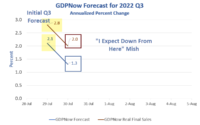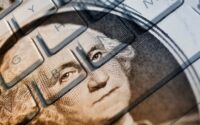China’s Covid-Hit Economy Leaves Door Open for PBOC Easing
(Bloomberg) — China’s worsening economic slump and a likely disruptive rollback of Covid restrictions will keep the central bank on its easing path, economists said, with calls growing for more interest rate cuts.
Most Read from Bloomberg
A Friday announcement by the People’s Bank of China to cut the reserve requirement ratio for banks — providing them with more cash to extend loans — came as a surprise to many analysts given the central bank’s recent warnings on inflation risks.
That suggests policymakers are becoming more concerned about the growth outlook as Covid cases surge to record levels. Tighter virus restrictions across major cities like Beijing and Guangzhou have cut economic activity further, while inflaming social tensions.
“The overwhelming goal right now should be to stabilize growth rather than containing inflation,” Yu Yongding, a former member of the central bank’s monetary policy committee, said in an emailed response to questions. “China should resolutely stick with an easing monetary policy.”
He called on the PBOC to cut interest rates and the government to sell more sovereign bonds to help finance infrastructure spending. China “should tolerate” higher debt ratios and inflation to some extent if necessary, he said.
The central bank isn’t done easing monetary policy yet, economists said, with the global outlook turning mildly more favorable for the PBOC. The Federal Reserve is expected to slow its interest rate hikes, taking some of the pressure off the yuan. Domestic inflation is also expected to remain relatively subdued.
Compared with 2020, the PBOC’s stimulus through traditional tools this year has been smaller. It’s delivered a combined 20 basis points of cuts to its policy interest rates, less than the 30 basis points for the whole of 2020. The RRR has been lowered twice this year, compared with three times in 2020.
Instead, the central bank has relied more on structural tools, financing by state policy banks and so-called window guidance to encourage lenders to grant more loans.
The stimulus has had a mixed result though: credit growth has been highly volatile this year, while household borrowing more than halved from the same level last year.
Wang Yiming, an adviser to the PBOC, hinted recently that central bank easing may prove less effective when borrowing demand in the economy is being suppressed by Covid restrictions.
That echoes warnings from several economists who say China is in a “liquidity trap” — a situation in which lower interest rates fail to spur lending because business and consumer confidence is too weak.
What Bloomberg Economics Says…
Looking ahead to next year, we expect the PBOC to lower the RRR by another 50 bps. It may also cut its one-year MLF rate, a key policy interest rate, by 20 bps. We think it would do that in two moves, with the first 10-bp cut in 1Q23.
David Qu, China economist
For the full report, click here
Any monetary easing will likely be targeted, structural and cautious, economists say, with policymakers keen to preserve policy room in order to deal with possible future global shocks.
The PBOC already appears to be doing so, as both of its RRR reductions this year were by just 25 basis points — smaller than previous cuts of 50 or 100 basis points. Those smaller cuts are likely to stay, economists say, as the central bank may have room for what amounts to some 280 basis points worth of reductions.
UBS Group AG said the latest RRR cut could be followed by more reductions in the ratio as well as a drop in deposit rates. Chinese banks could also lower their five-year loan prime rates, a reference for mortgage rates, by 5 to 10 basis points in coming months, UBS economists including Wang Tao wrote in a note.
Macquarie Group Ltd.’s Larry Hu said the PBOC will likely use more window guidance to urge banks to provide financing to property developers. That would be a more effective and targeted way to address one of the biggest headwinds facing the economy, he said.
Citigroup Inc.’s Yu Xiangrong sees a small chance for interest rate cuts. The PBOC will likely continue to support key sectors such as property and infrastructure, and “maintain a reasonable pace of credit growth through structural tools,” he said.
Already, the biggest state banks have pledged at least 1.28 trillion yuan ($178 billion) worth of financing to support to property developers as part of a push to ease turmoil in the nation’s real estate market.
Once China exits its Covid Zero strategy and reopens the country in the second half of 2023, as many economists expect, the subsequent economic rebound will probably make the PBOC scale back its policy easing later in the year.
“Monetary policy will continue to provide support by the spring,” said Ding Shuang, chief economist for Greater China & North Asia at Standard Chartered Plc. “The policy will likely remain loose in the current transition period, until the Covid policy shifts and the economy recovers.”
(Updates with additional details about policy room, comments from Citigroup Inc.)
Most Read from Bloomberg Businessweek
©2022 Bloomberg L.P.
[ad_2]
Source link


